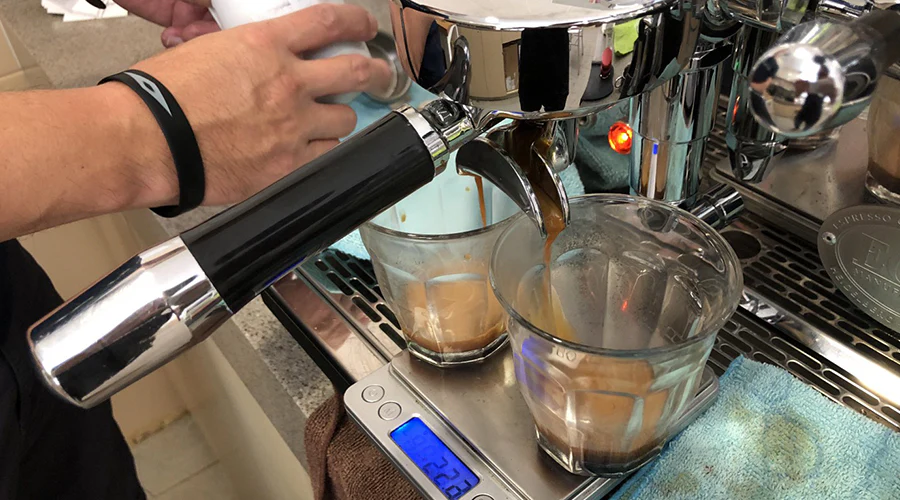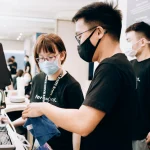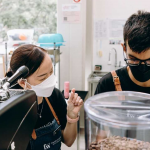Foreword Coffee trains and hires differently-abled persons, especially those with autism and the hard of hearing and Deaf community. Here we share a little bit of what we struggle in the workplace; to balance between creating a diverse and inclusive workforce, and having an efficient team.
In a bid to improve efficiency, we seek for our employees to specialize and be experts in their domains. The cashier performs her duties with little to no mistakes; the kitchen assistant supports the baristas; the junior barista doses the correct amount of coffee grounds and pulls the desired amount of espresso; the senior barista froths milk well and delivers each cup of latte consistently. In the grand scheme of things, our employees understand the importance of teamwork, where everyone plays their part and appreciates how a cup of coffee passes through many hands to be finally handed out to the customer.
We thought this plan was perfect because it allows us to hire people of different abilities to join our coffee kiosks and to perform just one function each in our workplace. The downside of specialization, however, is the need for more manpower in the coffee kiosks than if our employees acquire the skills to deal with more tasks. Also, specialization limits the salary for our employees as wages are pegged to skills and areas of responsibilities (i.e. in order for a junior barista to earn a higher wage, he/she has to go through competency tests to assess his/her skills to justify a wage increase based on skills development).
We need to go beyond merely providing jobs for persons with disabilities (PWDs) and to provide quality jobs which give them purpose and meaning. Many PWDs are usually underemployed which contributes to a lower quality of life than not having a job at all. One way which we are looking to do is to focus on employee retention by providing avenues for up-skilling, to make each employee more valuable through skills upgrading and for the employee to experience greater self-esteem through the skills gained.
Foreword Coffee largely works with persons with autism and the hard of hearing / Deaf community. As of May 2018, our workforce comprises of 6 differently-abled persons. We also accept students from various special education (SPED) schools in Singapore, and have since worked with Cerebral Palsy Alliance Singapore (CPAS) and Mountbatten Vocational School (MVS) to provide work attachment and internship opportunities for their students. Our differently-abled employees are all currently working part-time, as longer hours would tire them out at the end of the day. The challenge for us now is to stretch their stamina and to provide them with more skills training to perform dual roles in the coffee kiosks (most of them are good at just one role).

Behind the coffee bar: we teach our baristas to first pull espresso shots, then froth the milk. Multitasking is difficult, but we aim for them to be flexible in their tasks.
Teaching our employees to perform dual roles is different from teaching them to multitask; multitasking requires higher cognitive abilities and has shown to cause more mistakes and anxiety in the workplace. The barrier for our employees, especially those with autism, to perform dual roles lies in the tendency to be rigid in their behaviours. Studies have shown that behavioural rigidity is a core trait of Autism Spectrum Disorder (ASD) — so how can we overcome this in the workplace?
As employers, we learn not to place limitations on what our employees can do. Our junior barista, Mark*, has been with us for 4 months and has since mastered the recipes for all the drinks on our menu. He may “stone” for a short while when faced with confusing inputs during times of high stress (e.g. when he attempts to do more than one task at a time), but he doesn’t “escalate” and “meltdown” in the workplace. We were impressed with his performance and sometimes pleasantly surprised by the intentional touches he does for customers (e.g. writing words of encouragements on the cup sleeves for students during their examination period). Moving on, we look forward to increase his work stamina and convert him into a full-time in the next 3 months.

Mark* surprised me with this really good rosetta; the blob at the end of it was there as he was trying to pour the rest of the milk into the cup. I didn’t teach him to do this — he learnt it through Youtube.
On the other hand, Karen* does not take stress as well as Mark, and she deals with stress by singing. There was an occasion when she sang inappropriately (i.e. very loudly at the café where students are studying) and she was receiving glares from the people around her. She was very distracted during work that day, and I had to intervene multiple times to calm her down. She has been assigned as our cashier thus far, and we are planning to teach her how to also help out with the drinks in the coffee kiosk so that she can work in more than one area in the workplace, as we see the reduced need for a dedicated cashier especially during the off-peak hours. The challenge is for us to impart these skills complemented with reminders and visual cues in the workplace, so that she’s able to rely on these cues rather than memory to perform her tasks.
*Names are fictitious
It is imperative for every company to keep costs low while maintaining high productivity. As a social enterprise that seeks to provide quality employment for differently-abled persons, we face the challenge of balancing costs and productivity. Training our employees to specialize creates greater productivity but also comes with higher costs; while it may be more efficient to have one person to perform two roles, we need to also consider the capacity for our employees to do so. At the same time, we want to focus on employee retention and providing quality, meaningful work, rather than putting our employees in roles that are overly-specialized. We believe with empathy, patience, and dedication to grow our team, we can achieve the outcomes we have set for ourselves.

Latte art is important, but it is secondary to consistently producing great-tasting coffees which I teach our baristas to achieve. Don’t belittle a cup of coffee without its latte art!
I’ve been frequently asked, “what is the ratio of “able-bodied” employees to “special needs” employees?” It got me thinking if there is a magical ratio to achieve. In an informal memo from an executive in raiSE, he mentioned that their target is for social enterprises to achieve 20–30% of their total employment pool. Currently, 66% of our team are PWDs.
More isn’t necessarily merrier.
If every company dedicates resources to help successfully integrate just one PWD into their workplace, providing quality employment, this beats having 10 PWDs who are underemployed. Having said this, we would also not put a maximum quota on the number of PWDs we should employ, as long as we can meaningfully engage each and every one of them.
This blog post is written by Wei Jie, founder and director of Foreword Coffee. Wei Jie believes in the potential of people and sees the best in every person. He feels like a father working with his team, having to constantly give reminders, demonstrate patience, and be firm yet loving. It must be difficult for him, but it’s nothing compared to what caregivers sacrifice for their children.





